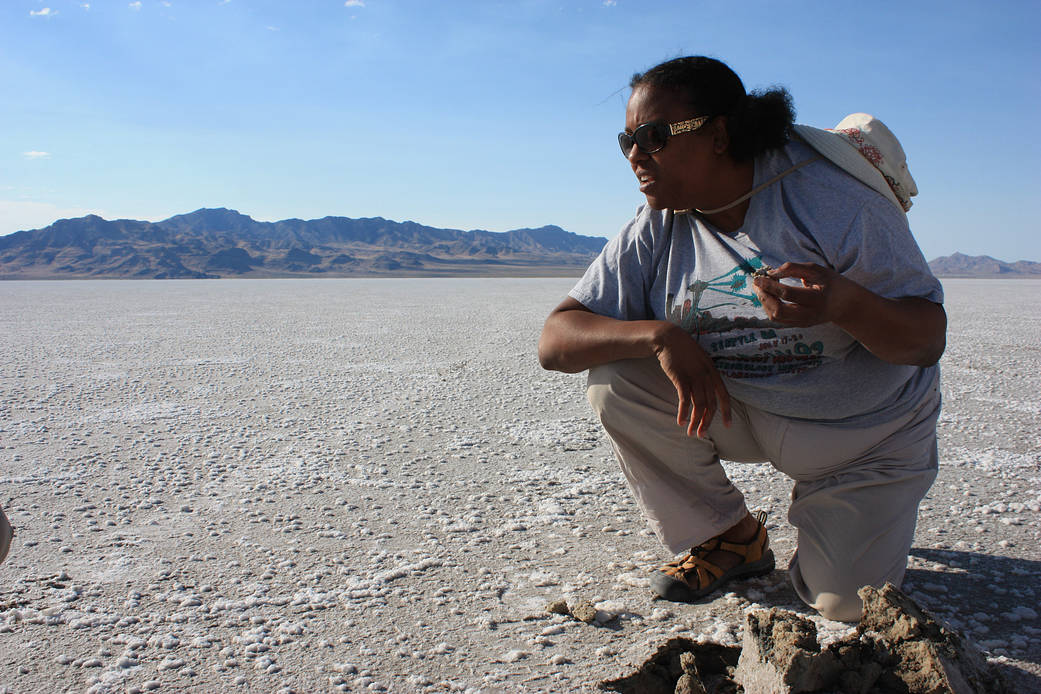If we find life on the Red Planet, we’ll have astrobiologists like Dr. Kennda Lynch to thank.
Lynch is an astrobiologist and geomicrobiologist studying life in extreme environments on Earth as models for characterizing habitable environments and searching for biosignatures on other planetary bodies in our solar system and elsewhere. Prior to obtaining her doctorate, she worked as a systems engineer for the International Space Station Program and as a research engineer for the Astromaterials and Exploration Science directorate, both at NASA’s Johnson Space Center. Hence, she combines her engineering experience with her science training to work across multiple disciplines within the astrobiology community.
Lynch’s current research focuses on studying life in hypersaline environments because recent data suggest the brines and salts are likely ubiquitous throughout the solar system and, especially on ocean worlds, are integral to habitable environments on planetary bodies.
In this image, Lynch examines brines, salts, and sediments in the Mars analog field site in Pilot Valley, Utah. Pilot Valley is a hypersaline paleolake basin that contains several aqueous minerals the have been detected on Mars. It also maintains a shallow groundwater system that hosts an amazing subsurface microbial ecosystem that includes perchlorate (a type of salt)-reducing bacteria. Her team studies the microbial ecology of the basin, and especially the perchlorate reducing bacteria, as an analog transitional habitable zone that could have occurred on Mars when surface water retreated in the Hesparian and groundwater became dominant again.
She is also starting a new study, in collaboration with European partners, of the Danakil Depression polyextreme analog environment in Ethiopia. Her other research interests include origins of life and early Earth environments, and development of in situ instrumentation.
Dr. Lynch is also very involved in mentoring students through the post doctoral level and is actively involved in increasing diversity in STEM education. Lynch is also a Ford Foundation Fellow and a proud lifetime member of the Girl Scouts. She was one of 100 women profiled in the book “Women of Space: Cool Careers on the Final Frontier” and was featured in the 2018 Netflix series “Explained” and in the 2020 Netflix series “Alien Worlds”.
View the Black History Month Image Gallery.
#BlackHistoryMonth
Image Credit: Courtesy of Dr. Lynch
如果我们在这颗红色星球上发现了生命,我们将感谢肯达·林奇博士这样的天体生物学家。
林奇是一名天体生物学家和地球微生物学家,他研究地球极端环境中的生命,作为描述适宜居住环境的模型,并在太阳系和其他地方的其他行星上寻找生物特征。在获得博士学位之前,她曾在国际空间站项目担任系统工程师,并在美国宇航局约翰逊航天中心(Johnson Space Center)的天体材料和探索科学理事会(Astromaterials and Exploration Science directorate)担任研究工程师。因此,她将自己的工程经验与科学培训相结合,在天体生物学领域内跨多个学科工作。
林奇目前的研究重点是研究高盐环境中的生命,因为最近的数据表明,卤水和盐类很可能在整个太阳系无处不在,尤其是在海洋世界,是行星上的宜居环境不可或缺的。
这张照片里,林奇检查了犹他州飞行员谷(Pilot Valley)火星模拟现场的卤水、盐和沉积物。飞行员谷是一个高盐度的古湖泊盆地,其中含有几种已在火星上检测到的含水矿物。它还维持着一个浅层地下水系统,它拥有一个惊人的地下微生物生态系统,其中包括高氯酸盐(一种盐)还原细菌。她的团队研究了该盆地的微生物生态,尤其是高氯酸盐还原菌,作为模拟的过渡性宜居带,当火星表面的水在赫斯帕里亚退却,地下水重新占主导地位时,可能会发生在火星上。
她还开始了一项新的研究,与欧洲伙伴合作,研究埃塞俄比亚的达纳基尔抑郁聚极端模拟环境。她的其他研究兴趣包括生命起源和早期地球环境,以及现场仪器的开发。
林奇博士还非常重视通过博士后阶段指导学生,并积极参与提高STEM教育的多样性。林奇还是福特基金会(Ford Foundation)的成员,也是令人自豪的女童子军(Girl Scouts)终身成员。她是《太空女性:终极前线的酷职业》(women of Space: Cool Careers on the Final Frontier)一书中介绍的100名女性之一,并在2018年Netflix电视剧《解释》(Explained)和2020年Netflix电视剧《异形世界》(Alien Worlds)中担任主角。
# BlackHistoryMonth
图片来源:林奇博士提供




yes